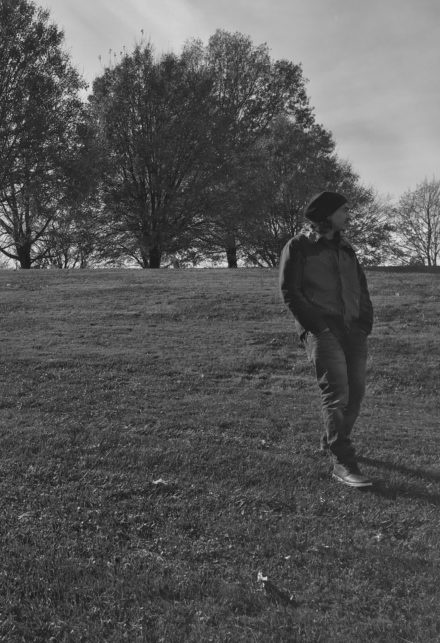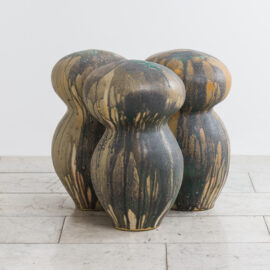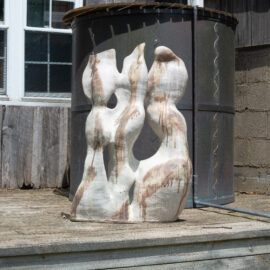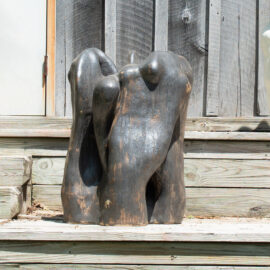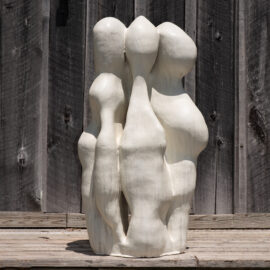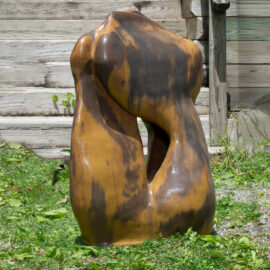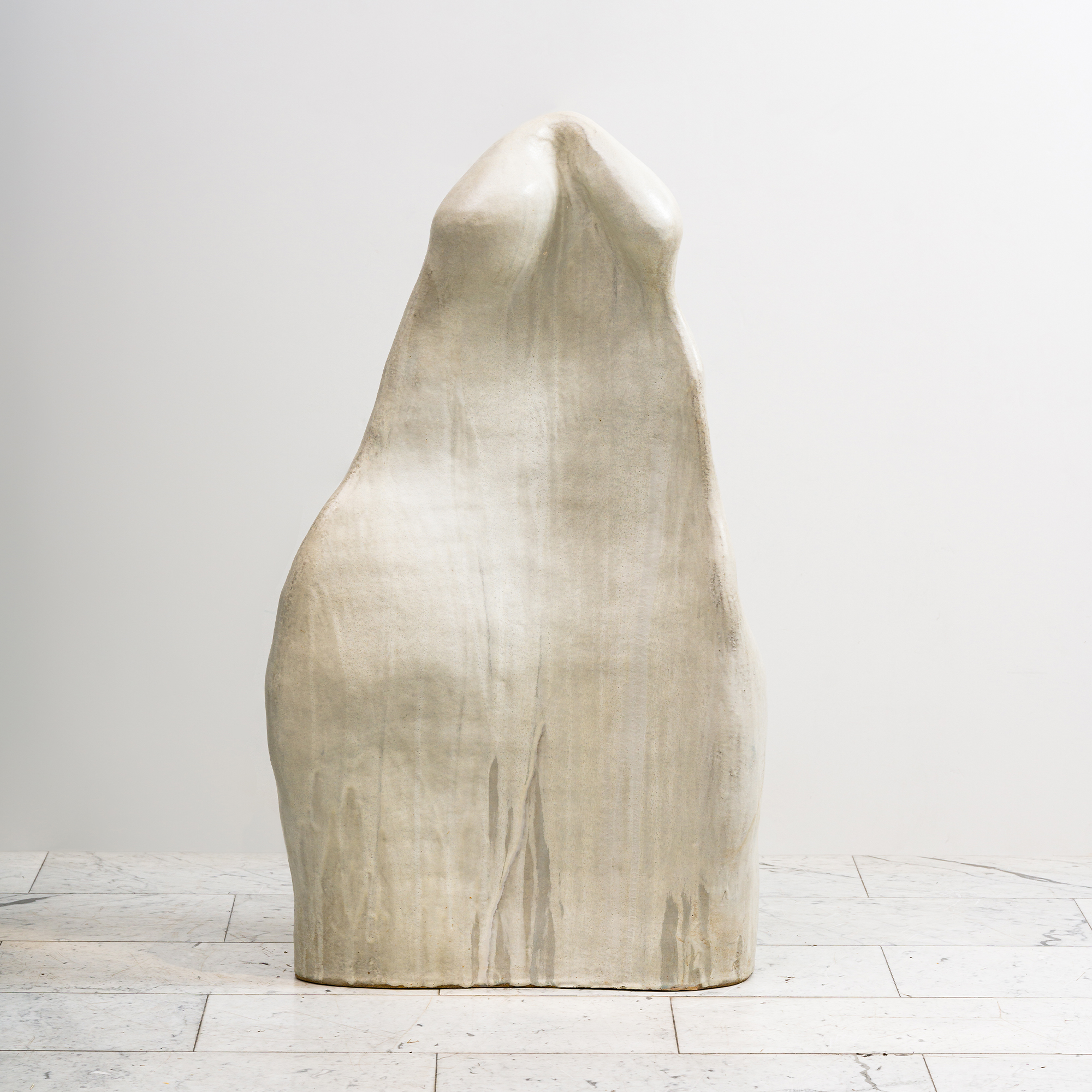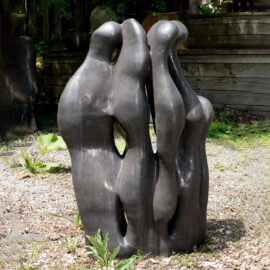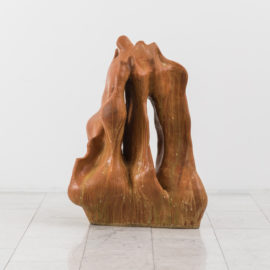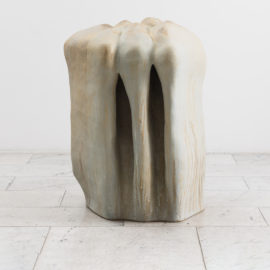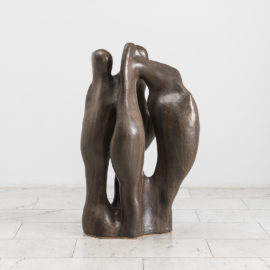Contemporary ceramist Curtis Fontaine unequivocally embodies the vanguard spirit of the artists of the 1960s who fostered a re-examination of the purpose of clay. Artists like Peter Voulkos and Toshiko Takaezu turned traditional thinking of pottery on its head with works that were expressive, challenging, and created specifically to exist in the aesthetic sphere.
Fontaine, a protégé and close friend of Takaezu, extends her legacy with works hinged on a seamless integration of cross-cultural ideas, traditional methods, and deeply personal intuition. While a visual kinship with Takaezu’s work is undeniable, his sculptures are more organic and more animated.
While working with clay is one of the oldest forms of artistic endeavor, ceramics have generally been relegated to the category of utilitarian and were, by and large, representative and highly decorative. Voulkos heavily relied on slab building to construct his stack pots. Takaezu’s closed vessels were made on the throwing wheel. Fontaine’s process involves coil building, allowing each work to emerge and evolve without the symmetrical restraint that the wheel dictates. Coil-building is dependent on instinct and a strong structural aptitude. Each work takes form, level by level, in a process that mimics natural development, like a leaf unfurling or a cloud forming, unrestrained.
With a distinct focus on spatial integration, his works are most successful for the harmony achieved in conjunction with their given environment, be that interior or outdoors. On the property of Takaezu’s rural New Jersey foundation, where Fontaine currently works, his sculptures populate the surrounding grounds like an ever-evolving sculpture garden, both responding to the natural environment and taking inspiration from it.
His organic forms are globular, playful, ambiguous, and sensual. Though a familial similarity underscores his work, each piece is exceedingly unique, varying in scale and shape, color and texture, telegraphing an almost intrinsic rhythm individually spawned from Fontaine’s spontaneous, free-form construction.
Because each clay body comes with its own limitations and abilities, the choices made during the formation and finishing of his sculptures are in response to how the type of clay behaves. The curves and spaces are decided at that present moment, and the sculpture itself starts to dictate what’s next. As each suggestive and obscurely biomorphic work swells and folds, associations can be made to figures, anatomy, or landforms, though actual representation never fully manifests.
His mostly organic colors are developed through a process of deduction and experimentation, ultimately relying heavily on luck, or as he describes, “constant failure and success.” In high-fired reduction kilns, glazes and clays reveal their true potential. Finishes are tied to the atmosphere of the firing, allowing for a large range of natural colors and blushing effects.
Fontaine grew up the middle of three children on the campus of Phillips Exeter Academy where his mother had been the Chinese Instructor since 1988. He describes the experience, “like a John Irving novel, picturesque under scrutiny.” He says, “With a Taiwanese mother the expectations were for me to be a doctor, so turning my focus from math to pottery was not ideal. But like my grandfathers from both the east and west, I needed to use my hands and I had a soft spot for finding beauty.”
One of his grandfathers had worked as a carpenter in New Hampshire, making forms in concrete for buildings like the gym at Exeter, as well as other fine carpentry work. His other grandfather, in Taiwan, studied architecture, played the violin in orchestras, painted watercolors, and was a professor of Arts in Tai Chung.
His career in ceramics began as a student at Exeter, studying under Ron Burke, and later his passion for the medium extended to an art degree from Skidmore College in 2009. However, Fontaine’s most influential association came during a series of apprenticeships with celebrated artist Toshiko Takaezu between 2007 and 2010. Fontaine and Takaezu developed a professional and uniquely personal relationship that continued until Takaezu’s death in 2011. An aesthetic kinship was formed, as well as a mutual understanding of the push and pull of American identity and Eastern heritage, or as he explains, “the back and forth required as a ‘happa’ or half and half.” The genesis of his abstract sculptures can be seen in Takaezu’s “closed form” works.
Living and working at Takaezu’s home and studio in Quakertown, NJ helped Fontaine develop a keen sense of form and technique. Toshiko instilled in her apprentices a technical rigor, aesthetic principles, and an approach to a studio practice that synthesizes nature, life, and art. On this method, Fontaine reflects, “I’ve had the good fortune of working closely with nature for many years. At an apple orchard, I saw functioning diversity. On an alpaca farm, I learned of the strength of life in the face of the elements and death. I am grateful to witness the passing seasons and create and reflect accordingly.
There is a very intimate experience achieved in Fontaine’s work that makes certain demands of the viewer. We are drawn inward by the forms’ absences and organically fashioned cavities, much like in the work of Richard Serra and Anish Kapoor. With the lack of conventional applications traditional in clay – vessel forms, figurative representation, etc. – we are left to our own devices. In the same manner that Fontaine employs to meet his ends, we too form our responses from pure impulse and intuition.


